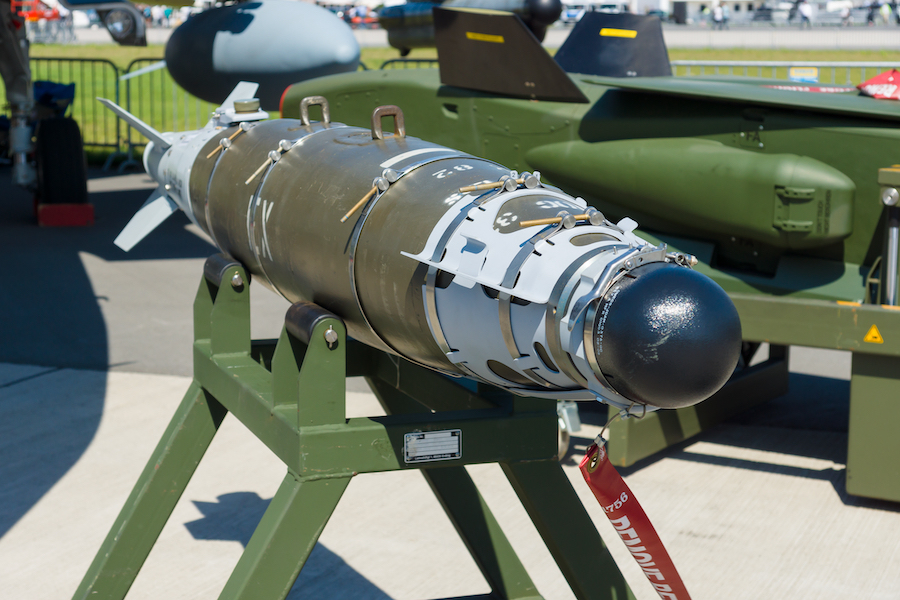NATO arms for Ukraine are constantly grabbing headlines – American and German Patriot missiles defend against Russian cruise missiles, Norwegian surface-to-air missiles are shooting down drones, America is ramping up High Mobility Artillery Rocket Systems (HIMARS) production to get more precision rocket and missile systems to Ukraine and Germany, the US, and the UK will send main battle tanks.
These are all great systems, but none will significantly impact the war in the numbers being sent. Oddly, the Biden administration’s decision to send Global Positioning Satellite (GPS) guided Joint Direct Attack Munitions (JDAM) to Ukraine garners little interest, even though JDAMs might turn the tide for Ukraine by getting their Air Force back on the offensive.
The Ukrainian Air Force has not made an offensive impact on the war to date because Russian air defenses have prevented Ukrainian manned aircraft from operating over Russian forces. Moreover, even when Ukraine could penetrate Russian defenses, they didn’t make an impact because they only had unguided “dumb” bombs and a handful of laser-guided missiles to use on targets. Dumb bombs take multiple missions and weapons to guarantee target destruction, and laser-guided weapons expose aircraft to enemy defenses while they guide the bomb to target. Hence, the risk of losing aircraft hasn’t been worth the gain for the Ukrainian Air Force.
JDAMs will change this risk calculation.
The Boeing JDAM precision guidance tail kits use GPS technology to turn dumb bombs into smart bombs capable of hitting a target within three meters. Once crews program a JDAM with target coordinates, the pilot flies to the point in space – the “basket” – where the JDAM can reach the target and then releases the weapon. The pilot doesn’t have to see what he is aiming at because the JDAM navigates itself to the target in any weather, day or night. JDAM kits will work with any Department of Defense general-purpose bomb from the 500lb. Mark 82 to the 2,000lb. Mark 84. In addition, any aircraft with a NATO standard bomb rack, a data interface, and a GPS receiver can carry a JDAM. The US has already figured out how to modify Ukrainian aircraft with this equipment. The US and their allies have massive numbers of JDAM kits; Boeing has made about 500,000 since 1998. They cost about $25,000 per kit – which may sound like a lot to the average civilian, but that’s decimal dust in defense budgets and magnitudes less than the cost of missiles and tanks.
Aircraft with GPS-guided weapons like JDAM have tremendous advantages over aircraft equipped with dumb bombs or laser-guided munitions. Ukrainian pilots with JDAMs can fly below Russian defenses, zoom up to toss their JDAMs into the launch basket, and then drop below Russian defenses again. Using these tactics, a pilot can take out multiple targets with JDAMs in a single mission without ever seeing the target and with reduced exposure to air defenses. In contrast, pilots with dumb bombs must fly into air defenses to see their target, line up on the target, and release their bombs from an exact point in space to hit. This means multiple aircraft flying against the same target to guarantee destruction. Single aircraft employing laser-guided weapons can take out single targets with great precision. Still, they must see their target and then keep a laser on target until the bomb hits, exposing themselves to enemy air defenses the entire time. Nighttime darkness, lousy weather, and smoke from previous bomb drops will interfere with dumb bombs and laser-guided munitions. Both types of munitions take a tremendous amount of training to deliver accurately.
The ability to put multiple JDAMs on any point in 3D space simultaneously using GPS guidance allows Airmen to do “geometric targeting.” Geometric targeting with JDAMs will enable pilots to simultaneously drop large numbers of weapons in precise 3D patterns for maximum effect, which is impossible with dumb bombs or laser-guided munitions.
Remember the 40-mile long Russian convoy stalled outside Kyiv in the early part of the war? Stalled convoys are an easy target for geometric targeting with JDAMs. Planners could aim a JDAM every few hundred feet along the road and program them to arrive simultaneously, exploding a few meters above the road for maximum blast radius. The effect would be devastating. Trucks and personnel carriers would be knocked over. Ammunition would explode inside tanks. Overpressure would kill any personnel inside the precisely measured, overlapping JDAM blast rings. Ukrainian pilots would only be exposed to Russian air defenses for as long as it took to pop up from low altitude, reach the JDAM launch basket, and drop their bombs.
Few, if any, fixed targets can withstand a concentrated geometric JDAM attack. Bridges? JDAMs impacting at the correct height on bridge abutments at either end will drop nearly any bridge. Deeply buried bunkers? Drop JDAMs into the same crater one after another. Airfields? A few dozen JDAMs would take out any airbase. Trenches go from being daunting ground defenses to convenient JDAM aim points.
The Ukrainian Air Force can rapidly employ JDAMs once they arrive in country. The US has already added NATO-standard bomb racks and data interfaces to Ukrainian MiG-29s to employ American AGM-88 High-Speed Antiradiation Missiles (HARMs). With the addition of a military-grade GPS receiver, these aircraft could easily employ JDAMs. Aircrew training is minimal because the pilot must only fly to a point on his GPS and release the JDAM. Something as simple as an iPad with the correct software could guide pilots. Maintenance is also minimal; JDAM kits are designed to stay on the shelf for years without maintenance and attach to bombs using common tools.
Ukraine already has plenty of experience with GPS-guided weapons due to NATO donations of HIMARS and M982 Excalibur 155mm artillery shells. Although HIMARS and Excalibur are very effective, one can’t compare their impact on the war with the potential effects of JDAMs. Ukrainian HIMARS has a range of 57 miles and Excalibur 25 miles, but range in artillery systems is a two-edged sword; moving closer to Russian targets to strike deeper brings them closer to Russian counter-artillery fires. Unlike aircraft that can move from one side of Ukraine to another in minutes, ground systems can take hours or days to move to a new firing location. Finally, size does matter in warfare; HIMARS rockets have a 200 lb. warhead, and Excalibur has only a 48 lb. charge—a single squadron of Ukrainian MiG-29s with 2,000 lb. JDAMs could drop four times as much high explosive as Ukraine’s entire HIMARS force.
Ukrainian fighters modified to carry NATO smart weapons give plenty of options for the US and their allies to increase pressure on Russia and permit deeper strikes if policymakers decide this is worth the risk of escalation. The JDAMs being supplied to Ukraine are relatively short-range because they do not have wings or engines that would allow them to fly long distances. Their range comes from the physics of the energy and altitude when released. A JDAM (the version currently being supplied to Ukraine) dropped from 25,000 feet will fly about 15 miles, and one released using the “zoom climb” tactics described earlier will only fly 5-6 miles. However, the Royal Australian Air Force and the Republic of Korea Air Force both have Boeing JDAM extended range (JDAM-ER) wing kits that extend the strike range to 50 miles. Boeing also makes the GBU-39 Small Diameter 250lb. bomb with wings that can fly over more than 69 miles to target. SDBs have a variety of guidance packages; GPS, laser, millimeter-wave radar, and infrared. There is even an experimental version that homes on radar signals like the AGM-88 HARM. SDBs may have a small warhead, but a MiG-29 could carry eight SDBs versus two 2,000lb. JDAMs. SDB warheads are highly effective due to their advanced fuses and bomb body design. A 250 lb. SDB has the same effects as a 2,000 lb. bomb against hardened targets like aircraft shelters. Boeing and Saab have also designed a ground-launched SDB (GLSDB) that fits into Ukraine’s HIMARS and is also being provided to Ukraine. Open sources say GLSDB can hit targets 60 miles away thanks to rocket engines taken from demilitarized cluster munition rockets.
Hence, the JDAM will make the Ukrainian Air Force relevant again while providing combat power the Ukrainians have yet to have to date. Their most significant impact will be against Russian defenses (trenches, bunkers, revetments, armored fighting vehicles) and the logistical facilities needed to support them (ammo dumps, logistical facilities, roads, bridges, rail lines, etc.)
An example of how JDAMs can crush enemy defenses while cutting them off from reinforcement and logistics was the very first time the US used JDAMs in large numbers, during the Battle of Mazar-e-Shariff in Afghanistan in November 2001 (which was portrayed in the movie “Twelve Strong”). Like the entrenched Russian and Ukrainian forces, Taliban and Northern Alliance troops had been in a stalemate – in this case – for two years because neither could break through the other’s fortifications. The Taliban were dug into much more formidable defenses than the Russians are in Ukraine and mountainous terrain, not the flat farmland of Ukraine. Northern Alliance scouts provided the location of every Taliban bunker by sneaking up on them with handheld GPS devices to mark their location; Ukrainians could use commercial drones to do the same. Using spy satellite imagery, coalition forces targeteers mensurated thousands of JDAM aim points along any possible road or trail the Taliban could use to reinforce the battlefield. Again, Ukrainians could use modern commercial satellite imagery. Less than 100 JDAMs sufficed to destroy Taliban defenses that had withstood months of artillery attacks and prevented thousands of Taliban and Al Qaeda troops from reaching the battlefield. Despite being outnumbered four-to-one and mounted on horses while facing an enemy with tanks and artillery, the Northern Alliance took Mazar-e-Sharif from the Taliban in less than seventy-two hours.
Imagine what Ukraine can do with JDAMs, and NATO-supplied main battle tanks instead of horses. Perhaps history repeating itself is a good thing.






